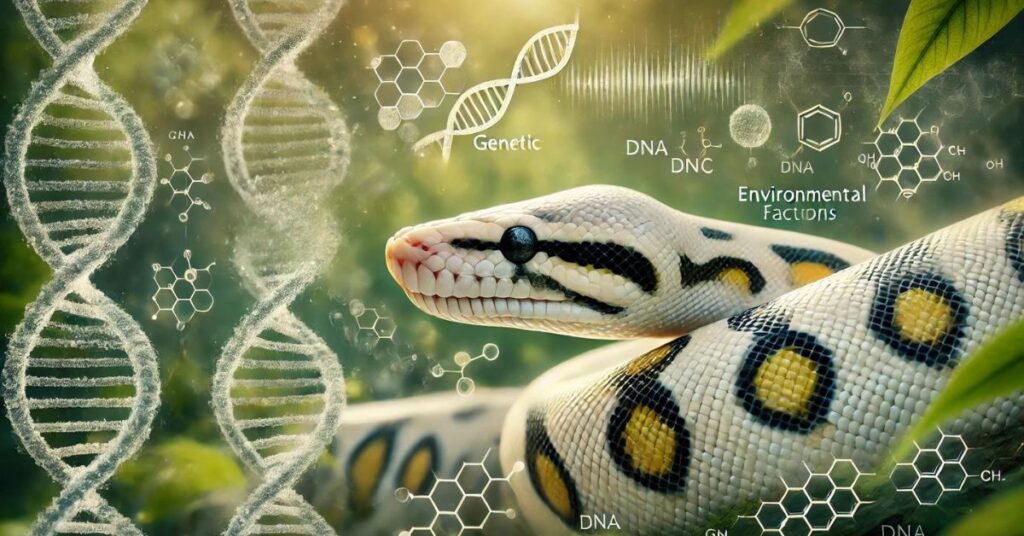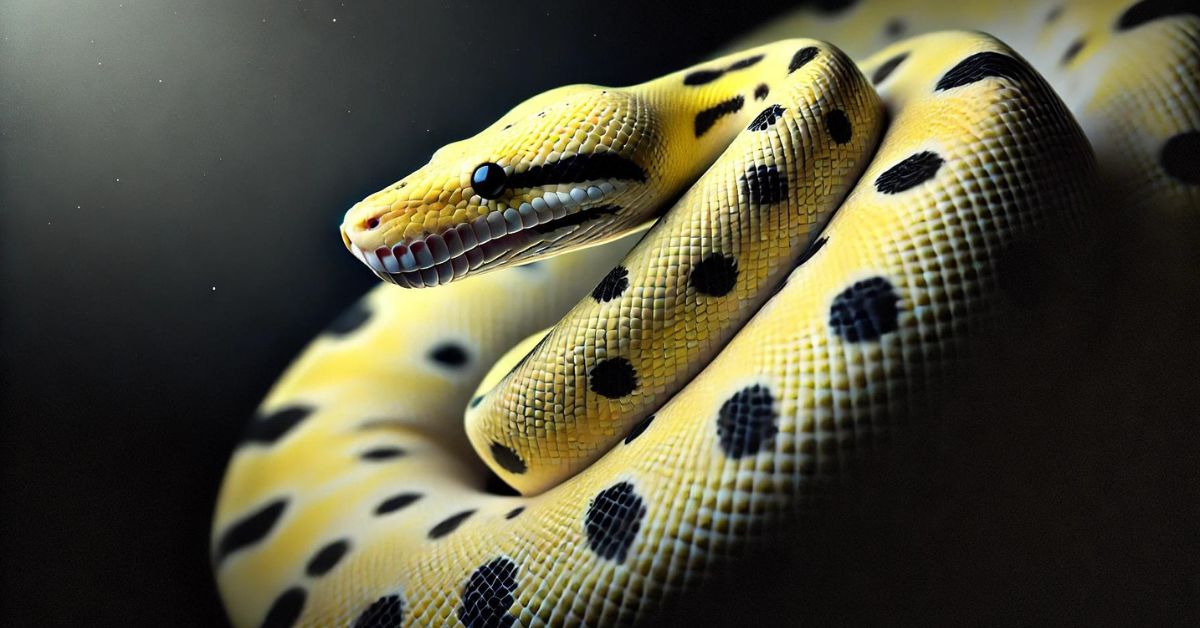The black spots on albino Burmese pythons are a fascinating phenomenon that has captured the interest of reptile enthusiasts and biologists alike. The albino Burmese python (Python bivittatus), already known for its lack of typical pigmentation, occasionally exhibits small, dark patches across its body. These black spots on albino Burmese pythons are unexpected, given that albinism generally results in a complete absence of melanin. The appearance of these spots raises questions about genetics, environmental factors, and the ecological role of these snakes both in the wild and in captivity.
In this article, we explore the environmental niche of black spots on albino Burmese pythons, delving into the habitat, behavior, and genetic causes of these unique markings. Additionally, we will discuss the significance of these snakes in both their native ecosystems and as part of the exotic pet trade, where the presence of black spots on albino Burmese pythons adds an extra layer of intrigue.
1. The Albino Burmese Python and the Mystery of Black Spots
The albino Burmese python is a visually striking snake, characterized by its pale yellow or white body, a result of its albinism. However, in some individuals, black spots on albino Burmese pythons emerge, creating a stark contrast to their otherwise light-colored bodies. These spots vary in size and number, making each affected snake unique.

1.1. Physical Characteristics of Black Spots on Albino Burmese Pythons
Albino Burmese pythons are known for their bright, pigment-lacking scales. In contrast, the black spots on albino Burmese pythons are small areas where pigmentation seems to persist despite the genetic mutation responsible for albinism.
- Appearance: The black spots on albino Burmese pythons are irregular in shape and can be scattered across the body or concentrated in specific areas. These spots can range in size from tiny speckles to larger patches, giving each snake a distinct appearance.
- Size and Distribution: The size of black spots on albino Burmese pythons can vary widely, and their distribution across the snake’s body is often random. Some individuals may have only a few spots, while others might have more extensive areas of pigmentation.
1.2. Genetics of Black Spots on Albino Burmese Pythons
Albinism is typically caused by a genetic mutation that affects the production of melanin, the pigment responsible for darker colors. However, the black spots on albino Burmese pythons suggest that melanin production may not be entirely suppressed in these snakes, leading to partial pigmentation in certain areas.
- Albinism Mutation: In albino Burmese pythons, a recessive genetic mutation inhibits melanin production, resulting in their light-colored appearance. The black spots on albino Burmese pythons are thought to result from incomplete suppression of melanin or a secondary mutation that allows limited pigmentation to occur.
- Unusual Genetic Expression: The presence of black spots on albino Burmese pythons is a rare occurrence and may be linked to variations in genetic expression. While the mutation for albinism typically prevents melanin production, these spots suggest that some genetic factors allow for the localized presence of pigment.
2. Habitat and Distribution of Burmese Pythons
Burmese pythons, including albino variants, are native to Southeast Asia and thrive in tropical and subtropical environments. The black spots on albino Burmese pythons do not affect their ability to inhabit these regions, though their unique coloration may influence their behavior and survival in the wild.

2.1. Preferred Habitats in Southeast Asia
Burmese pythons are semi-aquatic snakes that thrive in a variety of habitats, from forests to wetlands. The presence of black spots on albino Burmese pythons is a rare genetic anomaly that does not affect their habitat preferences, but their lighter coloration could make them more visible to predators and prey.
- Wetlands and Forests: Burmese pythons are commonly found near bodies of water, such as rivers, lakes, and swamps. The black spots on albino Burmese pythons may offer slight camouflage benefits in certain environments, but overall, their albino coloration is likely a disadvantage in terms of concealment.
- Role in Ecosystems: Despite their rare coloration and the presence of black spots on albino Burmese pythons, these snakes play a significant role as apex predators in their ecosystems. They help regulate populations of prey species, including rodents, birds, and small mammals.
2.2. Invasive Populations in the Florida Everglades
Burmese pythons, including albino varieties, have become invasive in the Florida Everglades. While black spots on albino Burmese pythons are unlikely to provide any advantage in this environment, these snakes’ ability to thrive in warm, wet habitats has led to their success in this non-native range.
- Impact of Invasive Populations: The introduction of Burmese pythons, both albino and wild-type, has had devastating effects on native wildlife in the Everglades. The black spots on albino Burmese pythons do not significantly affect their behavior or ecology, but their striking appearance makes them easier to spot compared to their camouflaged counterparts.
- Albino Burmese Pythons in the Wild: In the wild, albino Burmese pythons are less likely to survive due to their lack of camouflage, and the black spots on albino Burmese pythons do little to mitigate this disadvantage. However, in captivity, these snakes are prized for their unusual appearance.
3. Adaptations and Behavior of Burmese Pythons
The black spots on albino Burmese pythons do not significantly impact their behavior or ecological adaptations. Like other Burmese pythons, albino individuals are excellent hunters, using their muscular bodies to constrict prey and their environmental awareness to navigate their surroundings.

3.1. Hunting and Feeding Behavior
Burmese pythons are ambush predators, relying on stealth and patience to capture prey. The black spots on albino Burmese pythons may have little influence on their hunting success, but the albino coloration as a whole can make it more challenging for these snakes to remain undetected in the wild.
- Constriction: Once they capture prey, Burmese pythons use their powerful bodies to constrict and suffocate their prey. The black spots on albino Burmese pythons are a superficial feature and do not affect their strength or hunting ability.
- Dietary Flexibility: Burmese pythons, including those with black spots on albino Burmese pythons, are opportunistic feeders that consume a wide variety of prey, from small mammals to larger animals such as deer or wild pigs.
3.2. Thermoregulation and Environmental Challenges
The black spots on albino Burmese pythons may provide slight benefits in thermoregulation, though this is speculative. Like all reptiles, Burmese pythons are ectothermic and rely on external sources of heat to regulate their body temperature.
- Basking Behavior: In warmer environments, the black spots on albino Burmese pythons might absorb heat slightly more effectively than their lighter-colored surroundings, allowing the snake to warm up more quickly when basking in the sun.
- UV Sensitivity: Albino Burmese pythons are more sensitive to UV light due to their lack of melanin. The black spots on albino Burmese pythons might offer limited protection against UV exposure, but overall, albino individuals are more prone to skin damage in sunny environments.
4. Genetic and Environmental Factors Influencing Black Spots
The presence of black spots on albino Burmese pythons is a rare genetic phenomenon. While albinism generally results in the absence of pigment, these spots suggest that melanin production may still occur in certain localized areas of the snake’s skin.

4.1. Incomplete Melanin Suppression
In albino Burmese pythons, melanin production is typically suppressed by a genetic mutation. However, the appearance of black spots on albino Burmese pythons suggests that this suppression may not be complete in some individuals, allowing for the development of dark pigmentation in specific areas.
- Genetic Anomalies: The black spots on albino Burmese pythons may be the result of genetic anomalies that allow melanin to be produced in certain regions of the skin, despite the overall lack of pigmentation. These anomalies could be inherited or occur spontaneously.
- Variation Among Individuals: Not all albino Burmese pythons exhibit black spots, indicating that this trait is not universal among albino individuals. The black spots on albino Burmese pythons may be linked to specific genetic lineages or environmental factors that influence pigment expression.
4.2. Environmental Factors and Pigment Expression
While genetics play a primary role in determining the presence of black spots on albino Burmese pythons, environmental factors such as UV exposure and temperature may also influence their development.
- UV Exposure: The black spots on albino Burmese pythons may result from exposure to UV light, which could stimulate melanin production in certain areas. While albino snakes are generally more sensitive to sunlight, the presence of black spots could provide minimal protection against UV damage.
- Temperature and Stress: Environmental stressors, such as changes in temperature or habitat, may also play a role in the appearance of black spots on albino Burmese pythons. In some reptiles, stress can trigger changes in pigmentation, and it is possible that similar mechanisms are at work in these snakes.
5. Conservation and Ethical Considerations
The black spots on albino Burmese pythons add an extra layer of intrigue to these snakes, which are already popular in the exotic pet trade. However, the popularity of these snakes raises ethical questions, particularly regarding the impact of their captive breeding and the potential risks they pose if released into the wild.

5.1. Burmese Pythons in the Exotic Pet Trade
Albino Burmese pythons, especially those with black spots, are highly sought after by reptile enthusiasts. While these snakes can make impressive pets, their large size and specific care requirements make them difficult for many owners to manage.
- Challenges of Pet Ownership: The black spots on albino Burmese pythons may make them even more desirable in the exotic pet trade, but potential owners should be aware of the challenges associated with keeping such a large snake. Burmese pythons require large enclosures, specialized heating and humidity, and a steady supply of food.
- Potential for Release: Invasive populations of Burmese pythons, particularly in the Florida Everglades, are often the result of pet owners releasing snakes into the wild when they become too difficult to care for. The presence of black spots on albino Burmese pythons does not affect their potential to become invasive, but their bright coloration may make them more vulnerable in the wild.
5.2. Conservation of Burmese Pythons in Their Native Range
While Burmese pythons are considered invasive in some areas, such as Florida, they are not endangered in their native range. However, habitat destruction, poaching, and the exotic pet trade pose threats to wild populations.
- Conservation Efforts: Protecting the natural habitats of Burmese pythons, including those with black spots, is essential for their long-term survival. Conservation efforts in Southeast Asia focus on protecting wetlands, forests, and other critical habitats where these snakes thrive.
- Ethical Breeding: In captivity, responsible breeding practices are essential to ensure the health and well-being of Burmese pythons. This includes monitoring for genetic anomalies, such as the presence of black spots on albino Burmese pythons, and ensuring that snakes are not bred solely for their appearance without regard to their overall health.
Conclusion: The Fascinating World of Black Spots on Albino Burmese Pythons
The black spots on albino Burmese pythons are a rare and intriguing genetic phenomenon that adds to the mystique of these already captivating snakes. While albinism typically results in the complete absence of melanin, the appearance of black spots challenges our understanding of pigmentation and raises interesting questions about genetics, environment, and reptile biology.
As part of the exotic pet trade, the black spots on albino Burmese pythons make these snakes highly desirable, but their popularity also brings ethical considerations to the forefront. Understanding the environmental niche of Burmese pythons, both in the wild and in captivity, is crucial for ensuring their conservation and responsible management.
By continuing to study the black spots on albino Burmese pythons, researchers and conservationists can gain valuable insights into the genetics of pigmentation and the broader ecological roles of these magnificent reptiles.
Read More: The Environmental Niche of the Kinkajou Pet: Understanding the Species and Its Role in Captivity

